To recap: before counting planets in signs you must see if they remained in the same sign all day.
It also helps if you know the LOCATION your person was born, since time zones vary. Without knowing
the time zone you are looking at you can't know the specific 24 hours of planetary movement you are considering.
Things get confusing if this is the case.
When you have established which 24 hours you are dealing with, check which planets, if any changed sign.
These will have to be excluded from the counting that you will be doing.
Polarity
Making a count of planets in positive and negative signs provides the first balance to look into.
Please note that 'positive' and 'negative' do not in equate to 'good' and 'bad'.
Positive signs - illustrated in red - are assertive and active. Negative signs, shown in blue, absorb, listen and
assimilate.
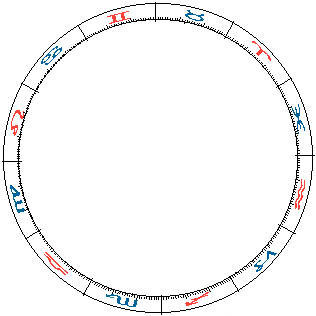
Each planet will be in an element. Here RED shows FIRE, BROWN shows EARTH, YELLOW shows AIR and
BLUE shows WATER. Note how each 'triplicity' of signs are linked by trine (120 degree) aspects, showing
their basic harmony and agreement.
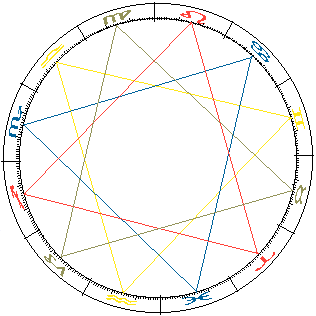
FIRE SIGNS Are enthusiatic, spontaneous, outward, daring.
EARTH SIGNS Are practical, constructive and reliable.
AIR SIGNS Are communicative, thoughtful and tend toward objectivity.
WATER SIGNS Are emotional. They understand the place of the irrational, and are often highly empathetic.
Quadruplicities - Qualities
Every planet is in one of the quadruplicities. Here RED is CARDINAL, BLUE shows FIXED and YELLOW shows MUTABLE.
Note how each 'quadruplicity' of signs are linked by square (90 degree) aspects, showing
the basic stress and (often creative) friction between them.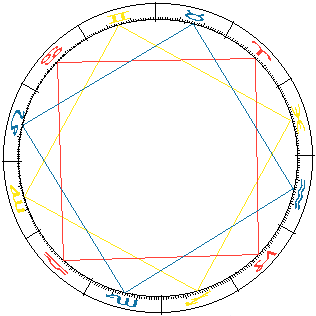
CARDINAL SIGNS Are highly active, initiating. They are leaders and are also prone to bossiness.
FIXED SIGNS Are reliable, stubborn and see things through. They can find it hard to let
go or change direction
MUTABLE SIGNS Are skilful negotiators, pay attention to detail - sometimes too much. These people
are highly flexible but can get lost in detail and be indecisive.
Orientations - Personal, Social, Universal
From the first degree of Aries, the zodiac moves through three 120 degree sections in this system,
which first came to my attention through a Richard Idemon book .
PERSONAL SIGNS (in RED) - Are concerned with a kind of "base" for oneself, being able to look after the number one. To be able to cook, eat,
dress and generally be OK alone. Imbalances here can indicate problems with this, as well as tendencies to (depending on which extreme)
either selfishness or selflessness. People with no planets in these signs usually get their
'sense of self' very much from outside themselves.
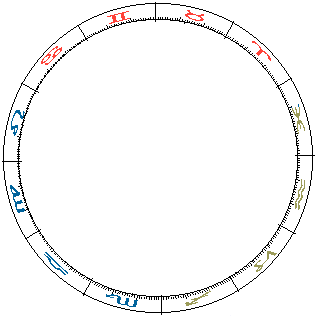
SOCIAL SIGNS (BLUE)- Are concerned with relating to other people. Those with many planets here are usually excellent
in connecting with others and may find it hard to be alone. Those weak in social sign placed planets tend to be
involved in working through personal challenges or highly motivated by 'the great beyond' of universal interests.
UNIVERSAL SIGNS (BROWN)- Themes beyond the immediate self and social connections are covered here. Big ideas -
religion, philosophy; life beyond the immediate and obvious are the realm of these signs. Those with many planets here
may show an inordinate concern for universal, political or environmental matters and be focused on 'the big picture' to
a high degree.
Analysis
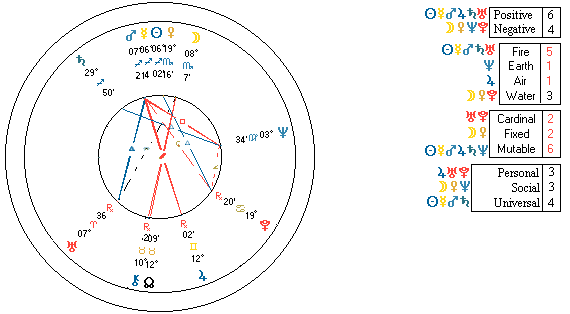
Above is the chart for the founder of Motown Records, Berry Gordy
(b 28th November 1929, Detroit, USA)
as an example of sign placement analysis. Ignoring placements for the ascendant and midheaven (not known as
the time of birth in this example is also unknown) as well as sign positions of planetoid Chiron and the Moon's
Node, we can generate the tables on the right. Note that on the day in question AND AT THE LOCATION IN QUESTION,
none of the planets, not even the Moon, changed sign, giving us 'clean' figures.
The most notable figures in the analysis are highlighted by being in red. From this we can see that Gordy is
high in Fire and so enthusiastic, spontaneous and daring. He is low in Earth and Air, so will be endeavouring
to develop his ability in practical, "hands on" matters and communicative ability. He has an average number of planets in water signs.
The chart is overwhelmingly strong in planets in mutable signs, though two planets in both cardinal and fixed
signs mean neither of these is highlighted dramatically. A high number of mutable placed planets indicates
flexibility, attention to detail, the ability to negotiate being strong, as well as the possibility that Gordy may
sometimes be indecisive or lost in detail.
These interpretations are borne out in the bare facts of Gordy's life. An ex-boxer, he started a jazz/blues shop
when young which went bust and then moved through the music industry as a songwriter to become a figure of great power
in Afro-American culture, earning that section of the US population greater recognition and self-respect through
Motown records and being central to the creation of legends such as the Supremes. Gordy's ability to take risks was central to
this, exemplified by his coming back from going bust and being a boxer. His enthusiasm won out and overrode any
early tendency toward a lack of realism. Flexibility (mutable placed planets) has also been shown in his career,
through contrasting occupations, the perfectionist music Motown produced, his ability to move through various positions in the
industry and his ability to "fine tune" the acts he discovered.
The 'background' of our portrait of Gordy is thus shown in the basics of his life.
continue reading





